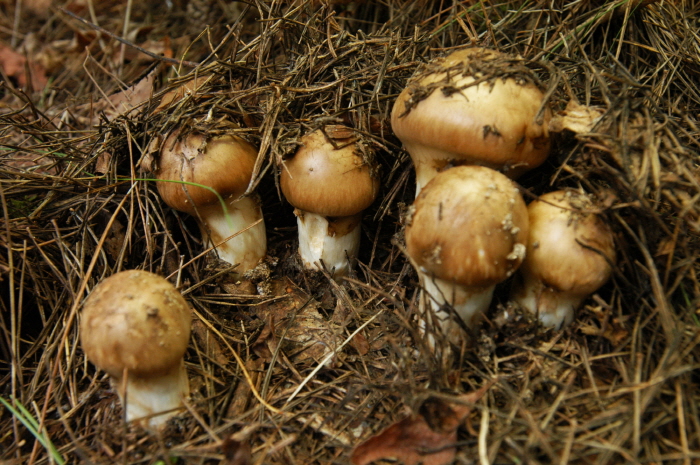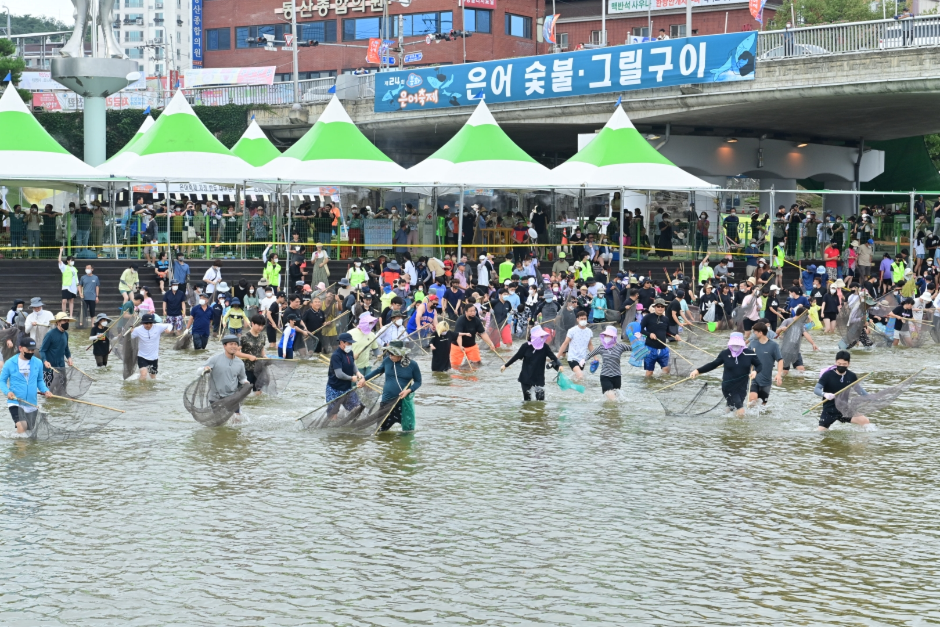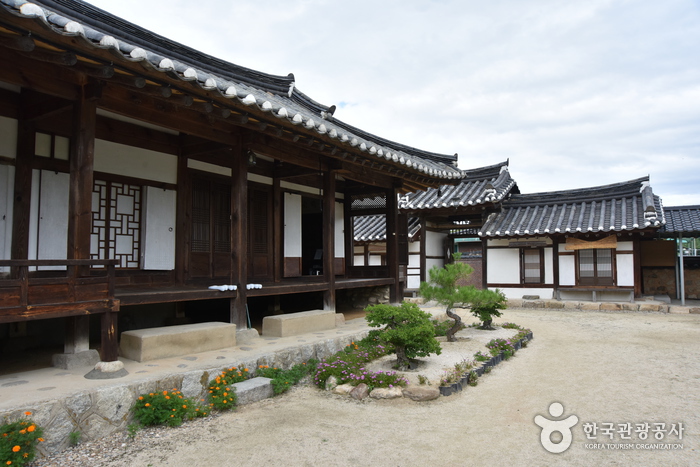Aldea Gunja de Andong (Sitio Arqueológico de Ocheon) (안동 군자마을(오천유적지))
15.2 Km 24398 2024-04-30
Gunjari-gil 29, Waryong-myeon, Andong-si, Gyeongsangbuk-do
La rama Ye-an del fundador del clan Gwangsan Kim, Hyo-ro Kim, creó esta aldea, y desde entonces sus descendientes han vivido aquí. En 1974, cuando se construyó la presa de Andong, la aldea fue transladada desde la zona de Yean-myeon hasta Waryong-myeon, también en Andong, manteniendo su forma original. Entre esos dos puntos, están los puntos culturales del pabellón Takcheongjeong y la residencia Hujodang. En la sala de exhibiciones del pabellón Sungwongak se pueden encontrar extraños archivos que relatan la historia de la familia. Algunos de esos documentos que se exponen son registros familiares, documentos inmobiliarios y registros sobre los sirvientes. Entre esos escritos, hay 7 diferentes que se muestran en 429 piezas.
Pabellón Takcheongjeong
Fue construido en 1541 por el jefe de la rama Ye-an del clan Gwangsan Kim. El pabellón es único y diferente a otros. Permanece como un tesoro y punto cultural muy importante. Durante la dinastía Joseon, el famoso calígrafo Ho Han le puso su nombre actual.
Residencia Hujodang
Esta residencia perteneció al jefe de Ye-an. La fecha exacta de su construcción se desconoce, pero fue realizada por Bupil Kim, quien vivió entre 1516 y 1577. La estructura fue construida separada de la casa principal. Los cuarteles anexos fueron divididos en áreas exteriores e interiores, siendo Hujodang la parte exterior.
Seongamje [Korea Quality] / 성암재 [한국관광 품질인증]
16.9 Km 180 2020-09-02
19-18, Seodong-gil, Bonghwa-gun, Gyeongsangbuk-do
+82-54-673-5011
Located in Chunyang-myeon, Bonghwa-gun, Gyeongsangbuk-do, Seongamjae is a traditional hanok built with pine trees (Geumgangsong) in 1915. It was owned by Seongam Gang Seungwon, the third son of Uijae Gang Pil of distinguished service to independence. Seongamjae is the place where Mr. Uijae Gang Pil delivered fund to the Provisional Government of Korea in Shanghai, which was then used by the 3rd division of army during the Korean War. Now, the grandson of Mr. Seongam Gang Seungwon and his wife are keeping the place and named it Seongamjae after his grandfather. They run it as a hanok open to the public in order to help spread history and culture. The owner couple has committed themselves to keeping the house and gardening. Nevertheless, the traditional hanok is equipped with modern facilities so that people of all age groups, Koreans and foreigners alike, may have a relaxed time here. Bordering Seongamjae is the National Folk Cultural Asset No. 279 Bonghwa Mansan Gotaek, home to the family of the owner of Seongamjae, and open to everyone who stays in Seongamjae. Cooking is limited in the hanok but there are restaurants nearby. Korean style Yeonbab is provided at 15,000 won per person when breakfast is booked in advance. As Chunyang Station of Yeongdong Line is a 5-minute walk away, the accommodation is conveniently located for train travelers. Note that luggage storage service is provided after check-in while visitors are enjoying walking, trekking, or travelling by train.
Festival del Songi de Bonghwa (봉화송이축제)
17.8 Km 18192 2024-02-28
Naeseong-ri, Bonghwa-eup, Bonghwa-gun, Gyeongsangbuk-do.
054-674-3053
Las setas songi (setas del pino) de Bonghwa están consideradas una especialidad de primer orden. Estas setas crecen solo en los pinos llamados chunyangmok, y pueden ser almacenadas durante largos períodos de tiempo. Durante el Festival del Songi de Bonghwa, los visitantes pueden ver estas setas en su hábitat natural e incluso tener la oportunidad de recolectarlas. También se pueden probar varios licores y especialidades locales elaborados a partir de las deliciosas setas songi.
Festival del Pez de Agua Dulce de Bonghwa (봉화은어축제)
17.9 Km 2826 2024-02-28
Naeseong-ri, Bonghwa-eup, Bonghwa-gun, Gyeongsangbuk-do
054-674-3053
El Festival del Pez de Agua Dulce de Bonghwa, que se celebra en el municipio de Bonghwa-gun, en la provincia de Gyeongsangbuk-do, ofrece numerosos programas interactivos que incluyen la pesca de pez dulce, carreras bajo agua y concursos de preguntas. La pesca del pez dulce, que tiene lugar dos veces al día en días laborables y tres veces los sábados, es la actividad más famosa del festival. Los ganadores de las carreras bajo agua y de los concursos de preguntas reciben especialidades locales como premio. Además, hay varios eventos educativos y culturales, tales como una exhibición de diversas especies de peces, un centro ecológico sobre el pez dulce en el que los visitantes pueden observar el hábitat natural del pez, el Museo de Moneda Coreana, el Centro Turístico Fotográfico de Bonghwa, pinturas sobre el pez dulce, cerámica, artesanías de hanji (papel tradicinal coreano), e inscripción en piedras.
Escuela de Protocolo de Andong (안동예절학교)
18.2 Km 2321 2023-04-07
Toegye-ro 1333-5, Waryong-myeon, Andong-si, Gyeongsangbuk-do
+82-54-841-0511
En la Escuela de Protocolo de Andong se pueden aprender las etiquetas y los modales tradicionales de Corea. Se encuentra ubicada en la ciudad de Andong, una región histórica que conserva la cultura confuciana y las tradiciones del pasado. La institución también ofrece clases interactivas de la ceremonia del té; para aprender a tocar instrumentos musicales como el janggu (tambor pequeño con forma de reloj de arena) y el gayageum (cítara de 12 cuerdas); participar en los juegos folclóricos, el yunnori (lanzar palos al aire) y el neoltwiggi (balancín); y otras muchas actividades culturales, como aprender la danza de máscaras, elaborar artesanías en papel tradicional hanji, preparar platos típicos, realizar la ceremonia de la boda tradicional y practicar deportes acuáticos en el río Nakdonggang. El lugar también es famoso porque en sus cercanías se encuentran otros destinos turísticos como la Academia Neoconfuciana Dosan Seowon y el Museo de la Ciencia Forestal.
Sogang House
20.0 Km 5128 2021-04-09
22, Baraemi-gil, Bonghwa-eup, Bonghwa-gun, Gyeongsangbuk-do
+82-10-9189-5578
The House of Sogang is an approximately 110-year-old house located in the village of Baraemi in Bonghwa-gun, Gyeongsangbuk-do. It was originally built for and presented to Kim Chang-gi (pen-name: Sogang), a well-known local Confucian scholar who served as the head of the Dosanseowon Confucian Academy, and who happened to be the second son of Kim Roe-sik (pen-name: Namho), the great-grandfather of the current owner.
Furthermore, the House of Namho, which is situated behind the House of Sogang, was built for the first son of Kim Roe-sik, one of the richest men in the region, who borrowed money using his entire property as security and donated it to a war chest. He won an official commendation for his role in helping secure national independence in 1977.
The entire village pf Baraemi is composed of traditional square-shaped houses with tiled roofs set amid a clean and peaceful atmosphere, for which it was designated as a Traditional Cultural Village way back in 1922. The name of the village, Baraemi, implies that it was originally situated by the sea, and many shell remains have been found in paddy fields and puddles there over the last 60 years.
The House of Namho is a typical square-shaped house with a tiled roof, and comprises a tall gate, a front courtyard, a sarangchae (men’s quarters) with maru (wooden floor), an inner courtyard, and a bonchae (main building) among its various structures. The main construction material of the house is Chunyang pine wood, which is a rarely used these days. Thanks to the owner-family’s dedicated maintenance and care, the house has been preserved in good condition. As the typical residence of a nobleman of the late Joseon period, the house is decorated with simple interior objects including an old electric fan and a cabinet inlaid with mother-of-pearl.
The house has seven guestrooms in total: The sarangchae consists of the Keunsarang and Jakeunsarang, each with a capacity of 4 to 5 people, and the Araetbang with a capacity of 2 to 3 people. In summer, guests can rent the Jakeunsarang and Sarangdaecheong together, or the Araetbang and Marutbang together, in order to have more space.
In addition, the anchae has a sangbang with a capacity of 3 to 4 people, while the mugangchae consists of Mungangbang 1, which is a red clay floor-heated room, and Mungangbang 2, which can accommodate 2 to 5 people. In summer it is possible to rent the entire House of Sogang, which can accommodate anywhere from 22 to 34 people (if the Sarangmaru and Marutbang are also rented).
Guests of the Keunsarang and Jakeunsarang can use a communal refrigerator, and the entire building has Wi-Fi access. Clean bedding is also provided. Although the house doesn’t provide a breakfast, the owner offers guests sweetcorn, sweet potatoes, fruit, etc. The house is also equipped with a BBQ facility, so guests can enjoy a BBQ party in the evening.
Guests can easily reach various nearby cultural heritage sites, including Muryangsujeon Hall of Buseoksa Temple, Sosuseowon Confucian Academy, which was the first Confucian Academy of Korea, Ojeon Mineral Spring, Daksil Village, and Chukseosa Temple.
The Namho house [Korea Quality] / 남호구택 [한국관광 품질인증]
20.0 Km 117 2020-09-03
21, Baraemi-gil, Bonghwa-gun, Gyeongsangbuk-do
+82-54-673-2257
Located in Bonghwa-eup, Bonghwa-gun, Gyeongsangbuk-do, Bonghwa Namho Gutaek is an old house from the Chosun period designated as Cultural Property Material No. 385. It was built by Nongsan Kim Nam Yeong in 1876 and his son Namho Kim Roe Sik had lived there. Mr. Kim Roe Sik was awarded with a medal for contributing his entire asset to military fund for the Provisional Government of Korea. The spirit of putting others and his country before himself continues until now. Having been built with high-quality materials, the 140-year old Namho Gutaek has barely suffered any deformation. In addition, attentive care added by the descendants has kept the traditional beauty of the hanok intact. One may even feel reverence at the Sosel Daemun (gate). In harmony with the hanok, the garden in the yard and the flower bed sitting next to the wall change color as season changes. It is a great place to feel the scent of old trees and get some rest. In 2016, the shared toilet was renovated in modern style to alleviate any inconvenience for the guests. In the spacious yard, there’s a spot for traditional games such as Tuho, Jegichagi, Neoltuigi, etc. Bonghwa Station (Yeongdong Line) is about a 15- minute walk away; an inner city bus stop in the town, on the other hand, makes a trip to other regions easy.
Tohyang traditional house [Korea Quality] / 토향고택 [한국관광 품질인증]
20.0 Km 10790 2020-09-10
43, Baraemi 1-gil Bonghwa-eup, Bonghwa-gun, Gyeongsangbuk-do
+82-10-8575-9036
This historic house has been the home of the descendants of Kim Yeo-byeong, one of the tenth-generation ancestors of its current occupants. Kim Yeo-byeong was born as the fourth son of Kim Seong-gu (courtesy name: Oheon, 1641-1707), founder of Uiseong Kim's Clan at Baraemi Village in Bonghwa and who was a great-great-great grandson of eminent Neo-Confucian official-scholar Kim U-goeng (courtesy name: Gaeam, 1524-1590). The house is comparatively large, featuring a square layout with a lofty five-bay gate building (soseuldaemun) and the main house of seven bays. The main building (anchae) of the house, located against the backdrop of a pine hill, is believed to have been built over 400 years ago before the founder of the family arrived at the village. The family guesthouse (sarangchae) was renovated in 1876 by Kim In-sik (courtesy name: Amun, 1855-1910), who served as the caretaker (Chambong) of Sunghyejeon Shrine, and Grand Master Tonghun before founding Joyang School, which would later become the present-day Bonghwa Elementary School. The name of the house, Tohyang, came from the courtesy name of Kim Jung-uk (1924-1967), a grandson of Kim In-sik. The latter was conscripted by the colonial authority ruling Korea at the time to serve the Japanese puppet state Manchukuo but fled during a military drill to become a freedom activist fighting against Imperial Japan in the Chinese cities of Suzhou and Hangzhou. He returned home after the 1945 Korean Liberation and studied in Jungang High School and Korea University before serving as a budget officer at the Economic Planning Board. The name of the house inscribed on the plaque hung under the roof of the gatehouse was written by his son Kim Jong-gu in honor of his life and achievements. At the front courtyard of the house is a lotus pond including barbecuing equipment and pottery kiln. In the rear garden is a folk playground with facilities and equipment for swinging, traditional Korean seesaw, shuttlecock-kicking, pitch-pot, and top spinning. The front courtyard also features rustic ceramic pots and rooftiles bearing poetic passages written by the mistress of the house who is a prize-winning poetess. The house provides visitors with an opportunity to experience traditional Korean cultural heritage such as pottery, calligraphy, poetry, and traditional musical instruments. Rich with the heritage of traditional Korean culture and lifestyle, the Historic House of Tohyang guides visitors to refreshment and healing obtained from the legacy of the peaceful rural life of days gone by.

![Seongamje [Korea Quality] / 성암재 [한국관광 품질인증]](http://tong.visitkorea.or.kr/cms/resource/47/2626147_image2_1.jpg)



![The Namho house [Korea Quality] / 남호구택 [한국관광 품질인증]](http://tong.visitkorea.or.kr/cms/resource/90/2626090_image2_1.jpg)
![Tohyang traditional house [Korea Quality] / 토향고택 [한국관광 품질인증]](http://tong.visitkorea.or.kr/cms/resource/57/2627457_image2_1.jpg)
 Español
Español
 한국어
한국어 English
English 日本語
日本語 中文(简体)
中文(简体) Deutsch
Deutsch Français
Français Русский
Русский